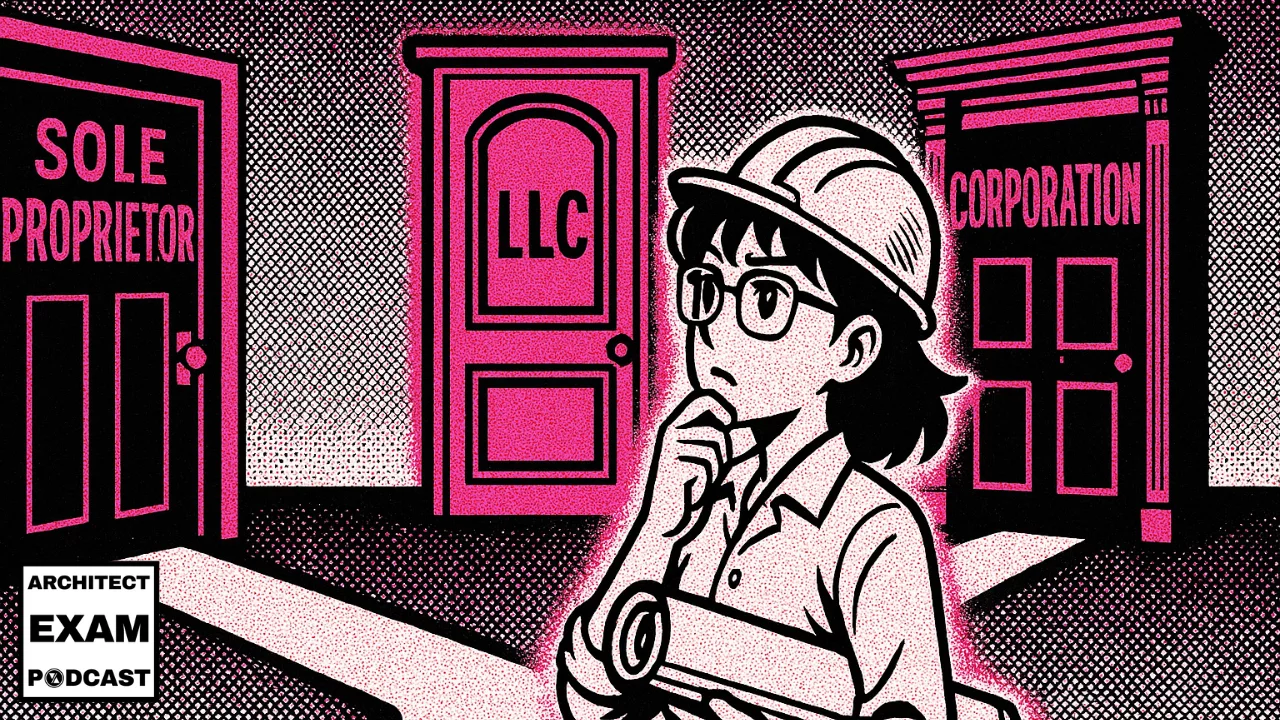Understanding the different business entity types for architects is about as exciting as watching concrete cure – but it’s absolutely crucial for your architecture career and the ARE exam. Think of this guide as the spinach smoothie of architecture knowledge – not what you’re craving, but exactly what you need!
This podcast is also available on YouTube, Spotify, and Apple Podcasts
The Partnership Dilemma: A Cautionary Tale
Let me share what happened to a colleague of mine – an incredible architect who started her own small residential practice. Business was booming when she got an opportunity to partner with another architect on a major commercial project.
Everything went great until they disagreed about the facade design. Words were exchanged, feelings were hurt, and suddenly the partnership dissolved. But here’s the kicker – they never formally established what kind of business entity they were operating under!
They assumed they were just “working together,” but legally, they’d created a general partnership by default. My colleague ended up on the hook for commitments her partner had made to consultants – costing her nearly $45,000!
This scenario isn’t uncommon. During our last ARE Bootcamp coaching session, we discovered over 80% of candidates had never formally learned about business entity types for architects in school. These topics get pushed aside for more exciting design courses, but understanding which business entity type is right for your practice can literally save your career.
The Business Entity Menu: Options for Architects
Think of business entity types for architects as types of buildings. Each has different features, different levels of protection, and different maintenance requirements. Let’s explore the menu of options available to architects:
It’s ironic that we architects spend years learning to design structures that protect others from the elements, but often forget to build the legal structures that protect ourselves from liability storms. We’ll obsess over a rain screen detail but overlook the business entity “waterproofing” that keeps our personal assets dry when problems start pouring down.
Sole Proprietorship: The Studio Apartment
The sole proprietorship is the “studio apartment” scale of business entity types for architects. It’s just you, doing your thing, with no separation between your business and personal finances.
Imagine your business finances and your personal finances are roommates sharing a studio apartment with no privacy curtain. Whatever mess your business roommate makes, you’re both living in it!
Benefits of Sole Proprietorships:
- Instant formation – No paperwork required to create it
- Complete control – All decisions are yours alone
- Direct profits – All income comes directly to you
- Minimal bureaucracy – Few administrative headaches
The Major Drawback:
- Unlimited personal liability – If a client sues your business, they’re suing you personally
For architects, this means your house, car, savings, and even that vintage Eames chair you splurged on are all fair game in a lawsuit. That’s why many architects start as sole proprietors but don’t stay that way for long. It’s like designing a building with no structural support – fine until something goes wrong, then catastrophic.
For ARE exam preparation, remember this key point: Sole proprietorships are the EASIEST to form but offer ZERO liability protection.
Limited Liability Company (LLC): The Loft Conversion
The Limited Liability Company (LLC) is like the “loft conversion” of business entity types for architects. There’s more protection, more flexibility, but still not overly complex.
An LLC is like installing a really good waterproof membrane between your business and personal life. When problems rain down on your business, your personal assets stay nice and dry.
Why LLCs are Popular with Architects:
- Limited liability protection – Your personal assets are protected if the business gets sued
- Flexible management structure – Run it yourself or share management with partners
- Tax flexibility – Can be taxed as a sole proprietor, partnership, or even elect S-Corporation taxation
- Fewer formalities than corporations – Less paperwork, fewer corporate requirements
Most tax attorneys recommend LLCs for about 80% of small to mid-size architecture firms. The modest cost and paperwork are well worth the liability protection, especially for design professionals whose work carries inherent risks.
For ARE preparation: Understanding that LLCs are relatively simple to form but provide significant liability protection is an important concept that appears on the Practice Management (PcM) division.
Limited Liability Partnership (LLP): The Townhouse
The Limited Liability Partnership (LLP) is the townhouse of business entities.
An LLP is like a row of townhouses with really good party walls. Each partner has their own unit, and if one catches fire, the others are protected.
Key Features of LLPs for Architects:
- Each partner is protected from the professional negligence of other partners
- Everyone remains liable for their own professional mistakes
- Partners share in management and profits
- Like LLCs, they enjoy pass-through taxation
Here’s a critical point many ARE candidates should know: In most states, LLPs are specifically designed for licensed professionals. That’s why you’ll sometimes see “PLLP” for Professional Limited Liability Partnership.
The classic LLP scenario is when several architects with different specialties join forces. Maybe one handles healthcare projects, another does residential, and a third focuses on sustainable design. They want to share resources but not liability for each other’s work.
Corporations (S-Corp & C-Corp): The High-Rise Office Towers
Corporations are the high-rise office towers of business entities.
A corporation is like a massive mixed-use development project – complex to design and build, expensive to maintain, but extremely durable and capable of housing much larger operations.
There are two main types architects should understand:
C-Corporations:
- Provide complete separation between the business and owners (shareholders)
- Offer the strongest liability protection available
- Have unlimited growth potential through stock issuance
- Require complex governance with boards of directors, officers, etc.
- Come with double taxation – the corporation pays tax on profits, then shareholders pay tax again on dividends
S-Corporations:
- Maintain all the liability protection of a C-Corp
- Offer pass-through taxation, avoiding the double taxation issue
- Limited to 100 shareholders who must generally be U.S. citizens/residents
- Can only have one class of stock
When studying for the ARE, I kept mixing up all these entity types until a study partner came up with this simple analogy:
“Think about how many times you’re taxed and how many people can come after your personal house if something goes wrong.”
That’s what it really boils down to!
- Sole proprietorships: one taxation, everything at risk
- LLCs and LLPs: one taxation, personal assets protected
- C-Corps: double taxation, best protection
- S-Corps: one taxation, best protection but more restrictions
Choosing the Right Business Entity: Scenarios for Architects
Let’s put this knowledge into practice with scenarios you might encounter in your architecture career (and definitely on the exam!).
Scenario 1: Solo Practice
You’re starting your own one-person architecture firm focusing on residential projects.
Your options when selecting business entity types for architects:
- A Sole Proprietorship would be easy but risky
- A Single-Member LLC requires a bit more paperwork but gives much better protection
- An S-Corporation involves more formalities but offers potential tax benefits if you’re earning significant profit
For most solo architects just starting out, a Single-Member LLC makes the most sense. It’s like wearing a helmet while biking – might seem unnecessary until you need it!
Scenario 2: Small Partnership
You and two architect friends want to start a firm together.
Your options:
- A General Partnership forms automatically if you work together without creating a formal entity – which is dangerous!
- An LLP works well if each of you will manage separate clients and projects
- An LLC is good if you’ll all work collaboratively on projects
- An S-Corporation is worth considering once you’re established and profitable
Most small architecture partnerships choose either an LLC or LLP. The decision often comes down to how you plan to divide project responsibilities.
Scenario 3: Growth and Expansion
Your firm is growing rapidly, considering bringing in outside investors, and maybe eventually going public.
Your options:
- A C-Corporation is really the only choice for significant outside investment or going public
- An LLC with multiple membership classes is possible for moderate growth while maintaining control
Very few architecture firms reach this stage, but those that do almost always convert to C-Corporations.
Business Entities and the ARE Exam
According to NCARB’s exam objectives for the Practice Management (PcM) division, candidates should understand several key aspects of business entity types for architects:
- Liability protection – which entities protect your personal assets
- Formation requirements – what’s needed to create each entity
- Management structures – who can make decisions
- Tax implications – pass-through versus corporate taxation
When preparing for the exam, focus on understanding business scenarios and which business entity type would be most appropriate for different situations.
Exam prep tip: When studying, remember that corporations offer the most liability protection but the most formalities and potential double taxation. LLCs offer good protection with more flexibility. Sole proprietorships offer no protection but maximum simplicity.
And remember this important concept: When architects work together informally without any formal business structure, they’ve likely created a general partnership by default – with unlimited personal liability!
If you’re finding these business concepts challenging, you’re not alone. Our PcM 101 course is specifically designed to break down these complex topics into digestible lessons. With over 15 hours of video content, 2 detailed case studies, excellent financial calculation resources, and more than 220 practice questions (many focusing specifically on business entity types for architects), you’ll master these concepts in no time. The course is part of our comprehensive ARE 101 course membership that prepares you for all divisions of the ARE exam.
Practical Considerations Beyond the Exam
Here are some practical considerations as you think about your future practice:
- For new graduates: Most new architects work for established firms, so you don’t need to worry about business entities yet. But understanding them helps you make sense of your firm’s structure and decisions.
- For aspiring solo practitioners: An LLC is almost always your best starting point. The modest cost and paperwork are well worth the liability protection.
- For groups of architects: Have the business entity conversation EARLY! So many architectural partnerships fracture because they didn’t establish clear expectations and structures from day one.
- For all architects: Remember that business entities are just one part of your risk management strategy. Professional liability insurance is equally important regardless of your entity type.
Reading legal documents about business entities feels remarkably similar to wading through Division 01 specifications – not exactly a page-turner, but ignore them at your peril. Just as missing a critical note in the specs can lead to construction disasters, skimming over business formation details can lead to financial catastrophes. The difference? At least with specs, someone might catch your mistake before it’s built.
Building a Foundation for Your Business
Understanding these different business entity types for architects isn’t just about passing the ARE – it’s about protecting the career you’re working so hard to build.
To recap the main business entity types architects should consider:
- Sole Proprietorships are simple but offer no protection
- LLCs provide good protection with flexibility, making them popular for small firms
- LLPs are designed for professional partnerships with separate projects
- Corporations offer the most protection but come with more complexity
Architecture isn’t just an art or a science – it’s also a business. And just like you wouldn’t design a building without understanding structural systems, you shouldn’t practice architecture without understanding business entity types.
The right business entity is like good drainage. Nobody notices when it’s working properly, but everyone suffers when it’s not!
Remember – before launching any architecture practice, consult with both an attorney and accountant who specialize in working with design professionals. State laws vary, and your specific situation might benefit from tailored advice.
Ready to take your ARE preparation to the next level? Enroll in our ARE Bootcamp today and join thousands of successful architects who’ve mastered these critical business concepts through our proven 10-week program. Don’t let business entity confusion stand between you and your license – get the expert guidance you need now!



